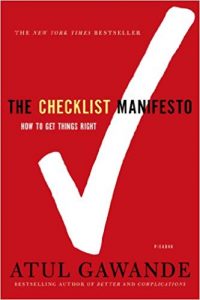 This post summarizes a wonderful book that is celebrating its ten-year anniversary. Atul Gawande wrote the best-seller The Checklist Manifesto: How to Get Things Right in 2009. It was the third book by the author and has become influential in healthcare and beyond.
This post summarizes a wonderful book that is celebrating its ten-year anniversary. Atul Gawande wrote the best-seller The Checklist Manifesto: How to Get Things Right in 2009. It was the third book by the author and has become influential in healthcare and beyond.
Gawande is a general surgeon at the Brigham and Women’s Hospital in Boston, a staff writer for The New Yorker, and an assistant professor at Harvard Medical School and the Harvard School of Public Health. In June of 2018, he was named CEO of the recently formed healthcare venture Haven, owned by Amazon, Berkshire Hathaway, and JP Morgan Chase.
I’ll let Gawande summarize the core idea from his book:
“Avoidable failures are common and persistent, not to mention demoralizing and frustrating, across many fields – from medicine to finance, business to government. And the reason is increasingly evident: the volume and complexity of what we know has exceeded our individual ability to deliver its benefits correctly, safely, or reliably. Knowledge has both saved us and burdened us.
That means we need a different strategy for overcoming failure, one that builds on experience and takes advantage of the knowledge people have but somehow makes up for our inevitable human inadequacies. And there is a strategy – though it will seem almost ridiculous in its simplicity, maybe even crazy to those of us who have spent years carefully developing ever more advanced skills and technologies.
It is a checklist.”
The book shares many examples where checklists have been used to improve results and save lives. Examples are pulled from healthcare, construction projects, food service businesses, venture capital investments, military and defense, and the airline industry.
When implementing a new checklist for a process or situation there are several important decisions you will need to make.
Checklist Types
There are two common kinds of checklists types:
- A DO-CONFIRM checklist, where team members perform the job from memory and experience, using the checklist at the end to confirm that everything was accomplished. Gawande instituted DO-CONFIRM checklists for healthcare practices, including to use when inserting central lines. At Lean East, we use weekly and monthly DO-CONFIRM checklists in Trello for tax and compliance work to ensure nothing is forgotten.
- A READ-DO checklist is used while the process is being completed. People carry out the tasks as they check them off, like following a recipe. READ-DO checklists help standardize non-routine processes. Examples include annual audits and emergency procedures.
Select a checklist type that makes sense for your situation.
Checklist creation
The checklist cannot be lengthy. Keeping a list to between five and nine items, the limit of working memory, is recommended. Use simple language and wording that the professional using the checklist will understand. Avoid clutter and unnecessary colors and keep ideally to one-page in length.
It is recommended to have checklists created or validated by the people who will be using the checklists. Users will know how to balance detail and brevity.
When to use the checklist
It is important to establish when to use the checklist and ensure it is easy to find and use. Some teams create books of checklists that are easy to reference. Others keep checklists at the point of use, so a checklist that confirms completion of a daily calibration may be posted on the machine itself. Keeping checklists stored in an easy-to-search online system is also an option, but realize that people may skip filling out the checklist if it takes extra time to print.
Some checklists are used regularly at set times, like when readying a plane for take-off, while others are used only in specific situations or emergencies.
How the checklist is used
Be sure someone on the team is accountable for completing the checklist. We recommend making specific people or specific roles responsible for the checklist completion. It is common for teams to have one person responsible for calling out tasks and checking items off the list when they are completed.
Decide if checklists should be used as a reference or filled out. Gawande instituted a DO-CONFIRM healthcare checklist that did not require nurses to use written checkmarks. However, in that situation, there was a process that documented that steps were completed.
What to do when the checklist is complete
We recommend you save completed checklists for several reasons:
- A periodic audit can be done to confirm prior checklists were completed. Was the checklist deemed to be beneficial?
- Review to look for suggested improvements to the checklist. Users should be encouraged to mark improvements on the checklist for later review and editing.
- Maintained as a documented record that the work on the checklist was performed. This may be valuable documentation in an investigation or be used in a court of law.
Let us know where you are using checklists and if they are working well for you. If they do not work well or are not used by the team, how can you adjust one of the variables above so that they become helpful?



Related Posts
The Continuing Evolution of the Employee Using AI
10 Great Leadership Lessons from Elon Musk II
10 Great Leadership Lessons from Elon Musk